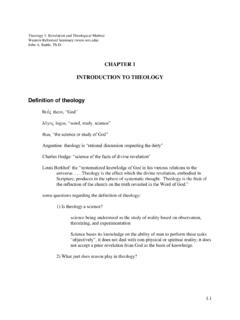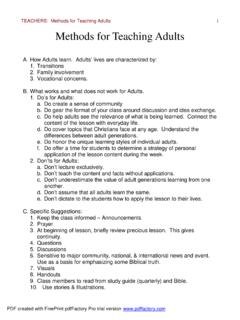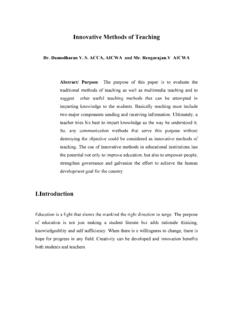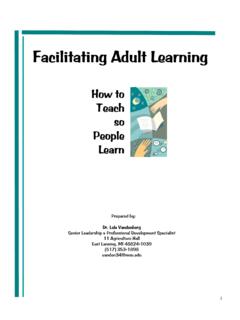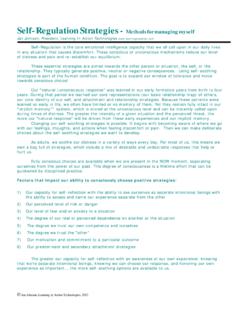Transcription of Bible Teaching Methods Learning Traits Five Kinds of ...
1 Bible Teaching Methods : Lesson 6, Learning Characteristics of Different Age Groups, p. 1 Bible Teaching Methods Knowing the Learning Traits of Your Class Age Group five Kinds of Learners (especially observable among adults ) 1. Content/substance oriented learners who like to process cognitive data and data connections 2. Goal/result oriented learners who have structured lifestyles and seek personal benefit from class time spent on the lesson rather than time spent on class members concerns 3. Context/activity oriented learners who enjoy class interaction and the process of Learning more than the targeted goal of the lesson 4. Implication/application learners. Similar to learner #2, this learner wants to move beyond the meaning of the Bible to the relevance of the Bible , and similar to learner #3, Learning is effected by hearing and relating to the life struggles of others 5. Leadership oriented learners who would rather teach the class and know that they learn best by preparing the lesson ADULT LEARNER CHARACTERISTICS Challenge of Teaching adults : they may think the Bible is familiar territory or that the Bible is not fully relevant to their situation Adult Learning Strengths 1.
2 Self-motivated 2. Self-disciplined (in general). Class behavior normally is orderly and respectful, and adults normally will follow through on assignments. 3. Self-learners. Often a teacher is not needed except to facilitate and guide. Some adult students will investigate the topic further outside of class. 4. Able to offer opinions from life experience. Teachers should welcome class contributions ..and feedback as one of the greatest assets of adult education (R&B, p. 246) 5. Focused on the relevance of the Bible lesson 6. Able to flourish in group/class settings. Most adults are comfortable with themselves in public. Adult Learning Traits 1. Desire for a safe Learning environment a. Fear of an educational setting b. Fear of embarrassment or failure Bible Teaching Methods : Lesson 6, Learning Characteristics of Different Age Groups, p. 2 2. Desire for an emotional/affective engagement in the lesson and Learning process 3. Desire to be stretched and to find resolution to relevant questions 4.
3 Desire for opportunity to connect and to reflect on lesson implications (self-discovery of new connections) 5. Desire for exposure to the unexpected in the midst of routine adult life a. New ideas or solutions b. Fresh Methods of Learning . A secure Learning environment might call for the same old weekly approach to the lesson, but actually adults desire fresh perspectives and Methods to stretch themselves. 6. Desire for the interaction and support of the Learning community (interaction with class peers and small groups) Methods for Teaching adults See the extensive Methods listed in Richards & Bredfelt, pp. 251-253 CHILDREN Learning CHARACTERISTICS Challenge of Teaching the Bible : 1) the Bible was written first of all for adults ; much of it is a closed Book to young children. 2) Teachers of children should connect with the parents of their pupils to seek reinforcement from the home and to give feedback from the class to the parents.
4 Advantage of Teaching children: the Bible is fresh and new, and children can exercise faith that reveals an intuitive understanding of God s presence. Children s Learning Traits 1. Children learn by doing and hands-on experience rather than by abstract talk 2. Children learn by example and they experiment with mimicking teachers and peers 3. Children can learn from stories and the protagonists of stories 4. Children learn through repetition AND the positive reinforcement of compliments 5. Children think literally/concretely and respond well to graphic stories with visual props, but young children are not able to understand the spiritual intent of object lessons or of parables. Methods for Teaching children 1. Storytelling Bible Teaching Methods : Lesson 6, Learning Characteristics of Different Age Groups, p. 3 2. Dramatics 3. Thought questions and discussions 4. Projects a. Crafts b. Beginning to use Bible resources like maps, atlases, Bible dictionaries YOUTH Learning CHARACTERISTICS Challenge of Teaching the Bible to youth: 1) motivating youth to see the relevance of God s timeless truth, and 2) understanding their transitional state between childhood and adulthood Advantage of Teaching youth: the Bible has answers for the life situations in which young people struggle, and youth are looking for heroes/models in their teachers and in the Bible .
5 Learning Traits of Youth 1. Youth learn best through direct experience. Offer OJT. 2. Youth learn best through personal discovery. Offer role play and small group discussions. 3. Youth learn from role models. Be a leader young people can follow. 4. Youth desire variety in Learning Methods as part of life discovery. 5. Youth are motivated to learn when the lesson and implications are relevant to their young lives. Useful Methods with Youth 1. Use Art forms. Young people appreciate the aesthetic qualities of visual art and music: cartoons, collages, murals, photography, posters, music with a message (folk music, Christian music). 2. Drama involves the youth in portraying a biblical scene or a modern situation. Consider pantomimes, puppets, choral readings, mock interviews 3. Other Visual mediums: we are trying to teach a timeless Book to a generation living in a multimedia world. Life to them is not linear nor sequential, but a simultaneous collage.
6 4. Verbal communication challenges a. Use stories (= graphic and filled with life) b. Use personal experience: yours and theirs
